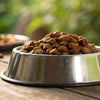How Often Should Small Dogs Eat? A Comprehensive Guide for Pet Owners
- Houndsy
Table of Contents
- Introduction
- Understanding Small Dog Nutritional Needs
- Crafting the Perfect Feeding Schedule
- Special Considerations for Small Dog Feeding
- Common Myths About Dog Feeding
- Conclusion
- FAQ
Introduction
Did you know that nearly 59% of dogs in the U.S. are considered overweight or obese? This startling statistic highlights the importance of proper feeding routines for our beloved canine companions. As dog owners, we all want to ensure that our pets maintain a healthy weight and receive the right nutrition. One of the most common questions pet parents ask is, "how often should small dogs eat?" Understanding the appropriate feeding frequency for small dogs can significantly impact their health and well-being.
In this blog post, we aim to provide you with a thorough understanding of small dog feeding schedules. We will explore the factors that influence how often small dogs should eat, the best practices for feeding them, and how our flagship product, the Houndsy Kibble Dispenser, can help streamline your pet feeding routine. By the end of this article, you’ll have all the insights you need to create an effective feeding schedule for your small dog while ensuring a joyful mealtime experience.
Let's dive into the nuances of small dog nutrition and how we can make feeding time a breeze!
Understanding Small Dog Nutritional Needs
The Importance of Diet
Small dogs have unique dietary needs due to their size, metabolism, and energy levels. Unlike larger breeds, small dogs typically have faster metabolisms, which means they burn energy more quickly. This increased metabolism often necessitates more frequent feeding to maintain their energy levels and prevent issues like hypoglycemia (low blood sugar), which can be a serious concern for small breeds.
Factors Influencing Feeding Frequency
- Age: Puppies, adult dogs, and senior dogs have different nutritional requirements. Puppies, for instance, may need to eat more frequently than adult dogs.
- Activity Level: Highly active small dogs may require more calories and, consequently, more frequent feedings.
- Health Status: Dogs with specific health issues may need tailored feeding schedules. Always consult your veterinarian if your dog has any medical concerns.
- Breed Characteristics: Different small breeds may have varying nutritional needs. For example, a Chihuahua may require a different feeding routine compared to a Pomeranian.
General Feeding Guidelines for Small Dogs
Typically, small dogs should be fed two to three times a day. Here’s a breakdown based on their life stages:
- Puppies (up to 4 months): Feed four times a day. Their growing bodies require more frequent meals to provide the necessary nutrients for development.
- Young Adults (5 months to 2 years): Transition to three meals a day. This schedule supports their energy needs while managing their weight.
- Adults (2 years and older): Most small dogs do well with two meals a day. This routine helps maintain a consistent metabolism.
- Seniors (7 years and older): Depending on their health, senior dogs may benefit from two smaller meals to prevent digestive issues.
Crafting the Perfect Feeding Schedule
Establishing a Routine
Creating a consistent feeding schedule is crucial for small dogs. Dogs are creatures of habit, and having a structured routine helps them feel secure. Here’s how we can establish a feeding schedule:
- Timing: Choose specific meal times that fit into your daily routine. For example, morning and evening feedings at the same time each day can create a sense of predictability.
- Portion Control: Measure the appropriate amount of food based on your dog's weight, age, and activity level. Tools like the Houndsy Kibble Dispenser can help ensure accurate portioning with every meal.
- Avoiding Grazing: While some small dogs may prefer to graze throughout the day, it’s generally recommended to avoid free-feeding. Grazing can lead to obesity and make it harder to monitor your dog’s food intake.
The Role of the Houndsy Kibble Dispenser
Our Houndsy Kibble Dispenser is designed with small dog owners in mind, making it easier to maintain a consistent feeding schedule. With features like a convenient crank at standing height, perfect portion control, and a mid-century modern design, this innovative product elevates your dog feeding experience.
- Ease of Use: No more bending down to fill bowls; our dispenser is ergonomically designed for your convenience.
- Perfect Portions: With a capacity of 25–30 lbs and BPA-free liner, you can ensure your small dog gets just the right amount of kibble every time.
- Aesthetically Pleasing: Its stylish design complements modern home decor, making it a beautiful addition to your living space.
You can explore our Houndsy Kibble Dispenser here.
Special Considerations for Small Dog Feeding
Managing Weight
Weight management is crucial for small dogs to prevent obesity-related health issues. Monitoring your dog's weight regularly and adjusting their food intake as needed is essential. If you notice any sudden weight gain or loss, consult your veterinarian.
- Caloric Needs: Generally, small dogs need about 40 calories per pound of body weight per day. However, this number can vary based on individual metabolism and activity levels.
- Treats: Be mindful of treats, as they can add extra calories. Opt for healthy treats and ensure they make up no more than 10% of your dog's daily caloric intake.
Feeding During Special Life Stages
- Puppies: Ensure your puppy receives high-quality, nutrient-dense food formulated for growth. Monitor their intake, as puppies need specific nutrients to support their development.
- Pregnant or Nursing Dogs: Pregnant and nursing dogs require increased calories and nutrients. Consult your veterinarian for a tailored feeding plan.
- Senior Dogs: Older dogs may need diets formulated for senior pets to support joint health and manage weight. Adjust meal sizes and frequency based on their activity levels.
Common Myths About Dog Feeding
Myth: Small Dogs Need to Eat More Often Than Larger Dogs
While it's true that small dogs have faster metabolisms, this doesn’t mean they need to eat significantly more often. Most small dogs thrive on a structured schedule of two to three meals daily, just like their larger counterparts, but with smaller portion sizes.
Myth: Free Feeding is Best for Small Dogs
Free feeding, or allowing dogs to graze throughout the day, can be detrimental. It often leads to overeating, making it difficult to monitor food intake. Structured feeding times foster better eating habits and help prevent obesity.
Conclusion
Understanding how often small dogs should eat is essential for their health and well-being. By establishing a consistent feeding routine, providing portion-controlled meals, and utilizing innovative products like the Houndsy Kibble Dispenser, we can enhance the feeding experience for both our pets and ourselves.
Reflect on your current feeding routine: Are you sticking to a schedule? Are you measuring portions? If you’re looking to elevate your dog feeding experience, consider the Houndsy Kibble Dispenser as a valuable tool in your pet care arsenal.
Explore our Houndsy Kibble Dispenser and take the first step towards a more enjoyable feeding routine for you and your small dog today!
FAQ
How often should small dogs eat?
Small dogs should typically eat two to three meals a day, depending on their age and activity level.
What should I feed my small dog?
A high-quality, nutrient-dense dog food specifically formulated for small breeds is recommended. Consult your veterinarian for personalized dietary advice.
Can I free-feed my small dog?
It is generally not recommended to free-feed small dogs, as it can lead to obesity and make it difficult to monitor food intake.
How can I manage my small dog's weight?
Regularly monitor your dog's weight, measure their food portions, and limit treats to maintain a healthy weight.
What if my small dog has special dietary needs?
Consult your veterinarian for tailored feeding schedules and food recommendations if your dog has specific health concerns or dietary requirements.













